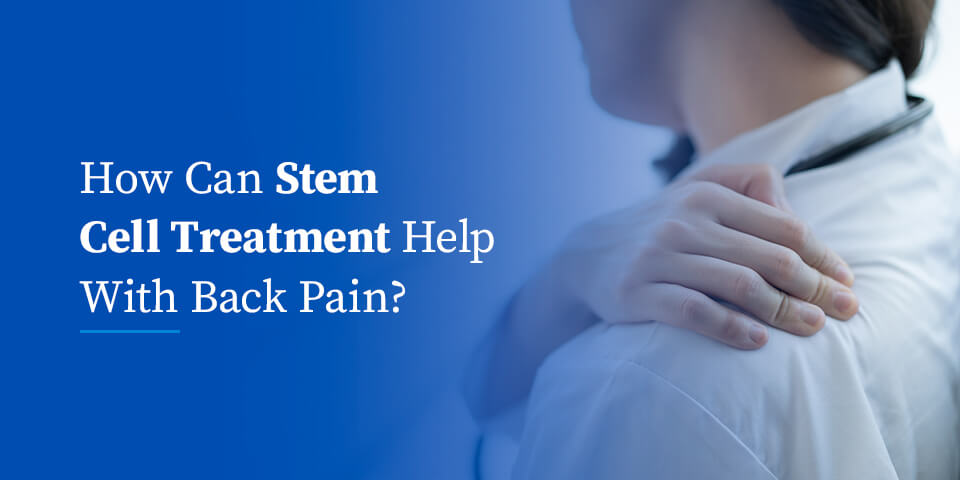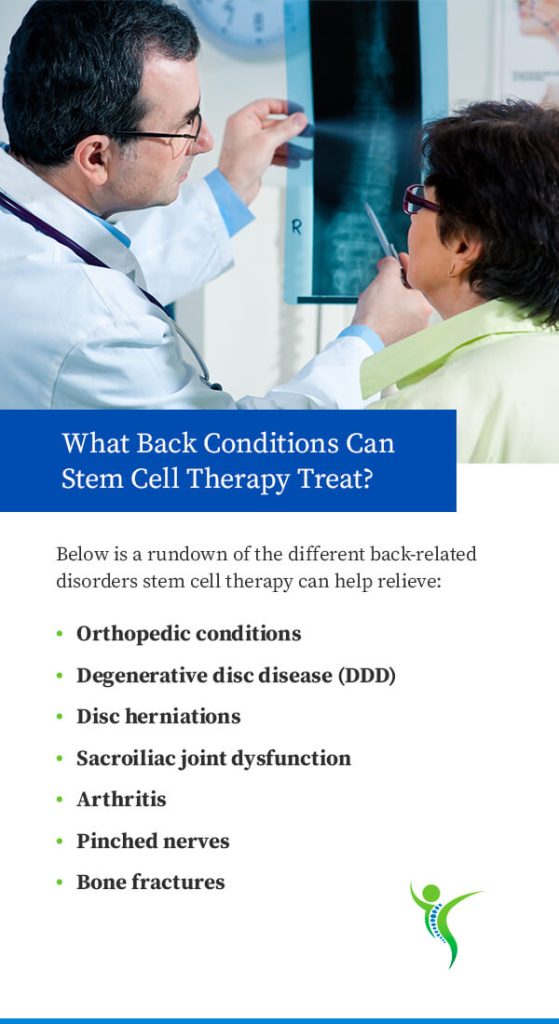Back pain is a condition that haunts many American adults and other individuals across the world, no matter their age. While most people try at-home remedies, chiropractors, massages and other methods to ease some of that pain, all these treatments only solve the pain for a short period.
One solution for back pain that you’ve probably never thought about or didn’t even know was an option is stem cell treatment. Learn more about stem cell medicine and how it can help back pain problems with this article.
What Is Stem Cell Therapy?
Stem cell therapy, also referred to as regenerative medicine, is an outpatient procedure that targets the underlying source of pain without medication, surgery or long recovery times. This procedure utilizes the body’s own healing ability to regenerate damaged tissues, decrease chronic pain and heal injuries more effectively. Stem cells can transform into bone, cartilage or fat cells to stimulate the body’s healing process.
Many areas in the body house stem cells, but the hip bones are rich in these cells, and they can be harvested quickly and easily. Within minutes of being harvested, the stem cells will be ready for use. The area that will be getting the stem cells is sterilized and numbed in preparation for injection.
Usually, some sort of image guidance, such as an ultrasound, is used to ensure the stem cells are placed exactly where they need to be. Then, the stem cells are injected to trigger a healing response in the body.
Stem cell therapy can be used to ease your back pain, but it can also treat degenerative disc disease, arthritis, pinched nerves, some bone fractures and some orthopedic conditions.
How Does Stem Cell Therapy Work for Back Pain?
Now you know how the stem cell injection procedure works, but you may be wondering how it will actually help your back pain. Back pain is one issue stem cells have been shown to relieve through increasing cell count for degenerative disc diseases and reducing the body’s inflammatory response.
Stem cell treatment is considered a regenerative therapy because it helps affected areas repair themselves when they are injected with stem cells. The stem cells used for this type of therapy can:
- Develop into whatever cells the body may need to help repair the affected area.
- Self-renew once they are injected, meaning they will continue working to repair and heal the body.
- Reduce pain by acting as an anti-inflammatory agent on damaged tissue.
The stem cells you receive conform to the area they are injected into and blend into the surrounding environment to do what your body needs them to do. These cells take a healing role in helping to address degenerative disc issues, lower back pain and other common back problems. Having the right microenvironment — which is the surrounding tissues the stem cells exist in — is essential to cultivating healthy and effective cells for a procedure.
Stem cell therapy has been around for a while, but as a fairly recent innovation, it remains an ever-evolving concept. Dr. Wenchun Qu of the Mayo Clinic presented six studies in 2017 that showed pain relief and improved function in patients who underwent the stem cell therapy procedure. Stem cell injections have also shown promise in treating chronic pain caused by numerous conditions, such as diabetic neuropathy and osteoarthritis. New studies continue to be released on this therapy.
While stem cell medicine can help those with back pain, it is important to remember that if you undergo stem cell therapy but continue previous actions that contribute to your back pain, you probably won’t see any progress. Before receiving this procedure, you’ll need to consult with your doctor to see if anything you’re doing may be contributing to your back pain. You will see more success if you can cut out or limit the actions contributing to your back pain prior to the procedure.
Stem Cell Therapy Procedure
Stem cells can be harvested from many places in the human body. Though the hip bone is a common area for harvesting stem cells, most procedures for back pain will cultivate them from the bone marrow. A machine called a centrifuge processes these harvested stem cells to create a compound known as bone marrow aspirate concentrate or BMAc.
This substance will contain the needed stem cells to promote growth factors and growth factor-rich platelets to help rebuild damaged tissues. These cells will also work together to cause an anti-inflammatory and immunomodulatory effect, which can relieve a layer of pain. Once the cells are ready, your physician will inject them into the affected area.
Stem cells can also be harvested from fat cells. In certain cases, liposuction can be performed to extract these fat cells and the stem cells within. Following liposuction, the stem cells can be reinjected into the treatment area.
Stem cells are often administered through intramuscular or intra-articular injections, though they can also be given intravenously. Injections usually do not require anesthesia. This is a simple procedure and typically won’t require an overnight inpatient stay — you can get back to your regular activities soon after receiving the stem cells. However, in the case of back pain and other back issues, patients will want to be mindful not to do any activities that could further exacerbate their pain or discomfort.
Whoever you choose to complete this procedure should be experienced and specially trained in this area. If they are not, they could potentially cause more damage rather than relieving your pain.
What Back Conditions Can Stem Cell Therapy Treat?
In theory, stem cell treatments don’t have limitations. While there are still ongoing studies that could prove or disprove this belief, we know stem cell therapy can help treat several other conditions and problems. Below is a rundown of the different back-related disorders stem cell therapy can help relieve:
- Orthopedic conditions. If you have pains in your hip, elbow, knee or shoulder or have carpal tunnel syndrome, bicep tendonitis, tennis elbow, frozen shoulder or shoulder osteoarthritis, stem cell therapy could be a great option for you. Patients often have multiple pain points at the same time, and some doctors will try to treat these problem areas simultaneously. If you have any of these orthopedic pains, consult your doctor about the possibilities of stem cell therapy.
- Degenerative disc disease (DDD). Though this condition is referred to as a disease, the term refers to the changes your spinal discs undergo over time. Spinal discs take on the stresses of your everyday actions. As we age, our discs lose their elasticity, flexibility and shock-absorbing abilities, which is where the pains set in. If you suffer from degenerative disc disease, consult your doctor about a stem cell treatment.
- Disc herniations. Disc herniations occur when disc materials are displaced beyond the normal area. When this happens, pressure is put on the spinal cord and/or spinal nerves, which results in severe pains, possible pinched nerves, numbness or weakness. Depending on the severity of your disc herniation, stem cell treatments can help relieve some of those pains.
- Sacroiliac joint dysfunction. Your sacroiliac (SI) joint is where your spine meets the pelvis. The job of this joint is to take on heavy loads to allow us to walk, run, jog, jump and more. When this joint becomes inflamed, this issue is known as sacroiliitis. This pain would most often be treated with physical therapy, massages or other non-surgical methods. However, stem cell therapy could be used in place of some of these techniques.
- Arthritis. Arthritis, or inflammation of the joints, is a common pain most people face throughout their lifetime. Most of us will experience this because as we age, our bones and joints begin showing signs of wear and tear from our daily activities. Additionally, arthritis is common in those who play sports, as their joints experience high impacts. Stem cell therapy can be used as a pain relief tactic for people coping with arthritis — specifically cases in the hands, elbows, knees, hips or shoulders.
- Pinched nerves. Pinched nerves, also known as radiculopathy, involve damage or irritation of the nerve roots that exit the spine. If you are suffering from a pinched nerve, you could experience things like mild or severe pain, sensation changes or strength changes. Typically, physicians may use physical therapy or oral medications to treat pinched nerves, but you can talk to your doctor about stem cell treatments. Those stem cells fighting to help the affected area heal could be just what your nerves need.
- Bone fractures. Some bone fractures have trouble healing on their own. Undergoing a stem cell treatment can give your fracture the help it needs to begin the healing process and properly grow back together.
As you can see, stem cell treatments can help with many different pains and issues. If you’re suffering from any of these conditions or maybe even a different pain, talk with your doctor to see if stem cell therapy is an option for you.
What Are the Benefits of Stem Cell Therapy?
The benefits of stem cell therapy for back pain include the following:
- Quick recovery time: Because this is an outpatient procedure, you can quickly get back to your life without needing any major downtime.
- Pain relief: Previous studies have shown that stem cell therapy can have positive outcomes for treating chronic pain.
- Lasting solution: Because stem cells help the body regenerate and directly target the source of your pain, they can be effective for providing lasting relief for the root issue instead of only alleviating the symptoms.
- Non-surgical procedure: Stem cells can be administered through injections or intravenous routes and do not require anesthesia, which can make this procedure a good choice for people searching for non-invasive options.
How Does Stem Cell Therapy Compare to Other Types of Regenerative Medicine for Back Pain?
While stem cell treatment is a great option for back pains, other excellent choices are available as well:
Platelet-Rich Plasma (PRP) Therapy
This therapy uses platelet-rich plasma obtained from the patient’s blood. The blood sample is separated to isolate the plasma, which is then injected back into the patient’s affected bodily area. This treatment was first used on athletes who needed to heal and get back to work quickly. After the success it had with athletes, it was made available to others.
PRP is best for assisting those with acute injuries who need to recover quickly or helping the healing process after surgery. Similar to stem cell therapy, PRP helps stimulate healing.
Prolotherapy
Prolotherapy is another treatment for muscle and joint pain, which involves repeated injections of an irritant solution into the joint. Typically a sugary solution, the irritant is believed to trigger growth in the connective tissue, which helps reduce the pains. This treatment is still relatively new, so there aren’t many studies on the results it can produce.
In the few existing studies for prolotherapy for lower back pain, the results were often mixed, but many patients did experience positive outcomes. Talk to your doctor about this procedure and see if it could help your pain.
Exosome Therapy
Exosomes are small vesicles released by the cells. They are like little messengers that carry important signals, proteins and genetic information from cell to cell. This therapy can help improve signaling between cells, reduce inflammation, help cells regenerate and modify the body’s immune response when it isn’t in good health.
Because exosomes facilitate communication between cells, they send signals to certain cells to begin the healing process when they are inserted into the affected area, helping the body return to normal health. Like other therapy options, this treatment could help alleviate some of your back pain, and you should consult your doctor about whether it could be beneficial to you.
Each of these types of therapies is similar in how they signal your body to start healing. There isn’t necessarily one technique that will work better than the other, as the treatment plan that best fits you will depend on the details of your specific type of pain and back issues. You can learn more about the different regenerative medicine treatment options on our website or by getting in contact with us.
To ensure you get the best treatment for your specific pain or disorder, consult with a spine specialist. Everyone’s body can react differently to various treatments. Ask your doctor what treatment plan would fit your body and lifestyle to ensure you get the most effective results.
Contact Spine INA for Stem Cell Therapy Consultation in New Jersey
At Spine INA, we specialize in numerous conditions for treating back pain, spinal issues and orthopedic problems for patients in New Jersey. No matter where you’re having pains on your body, we can help. We can also offer you several treatment options to best fit your unique case, including stem cell therapy.
If you’re interested in what conditions we can treat, explore our site to learn more. If you’d like to get more information on our treatment options, call us at (609) 371-9100 or contact one of our spine specialists today. Let us treat your spine pains and help you get on the road to pain relief!













